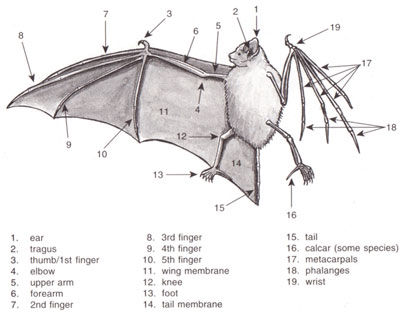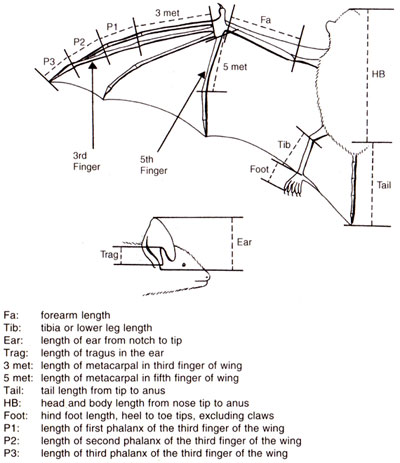There are 75 bat species known in Southern Africa, of which 56 species occur in South Africa. Of the 56 species, 39 are found in the northern part of South Africa, which comprises Gauteng, Limpopo, Mpumalanga and part of Northwest Province. The Chiroptera is subdivided into the larger fruit-eating bats that belong to the Suborder Megachiroptera and the smaller predominantly insect-eating Suborder Microchiroptera.

Figure 1: The general anatomy of a bat. Image from Taylor (2000).

Figure 2: The body parts that may be measured by scientists when identifying bats. Image from Taylor (2000).
South African bats may live in a variety of different places and the choice of roost usually differs with the species. These different roosts can include caves, cracks and crevices in rocks, under loose bark, under overhanging leaves, inside road culverts or hollow tree trunks (especially baobab trees), aardvark burrows, in basements and as many people already know, inside roofs. Only bats associated with human structures or gardens are discussed here. Almost all our insect-eating bats forage at night and seem to be opportunistic in their choice of food, limited only by the size and/or hardness of the bug.
|
Bat Species |
Gauteng |
North West |
Limpopo |
Western cape |
|---|---|---|---|---|
|
♦ |
♦ |
♦ |
||
|
♦ |
♦ |
♦ |
♦ |
|
|
♦ |
♦ |
♦ |
||
|
♦ |
♦ |
♦ |
||
|
♦ |
♦ |
♦ |
||
|
♦ |
♦ |
♦ |
♦ |
|
|
♦ |
♦ |
♦ |
♦ |
|
|
♦ |
♦ |
♦ |
||
|
♦ |
♦ |
♦ |
||
|
♦ |
||||
|
Long-tailed greater serotine |
♦ |
♦ |
||
|
Lesueur’s wing gland bat |
♦ |
|||
|
Angolan wing gland bat |
♦ |
|||
|
Kuhl’s pipistrelle bat |
♦ |
♦ |
♦ |
|
|
Banana bat |
♦ |
|||
|
Hildebrandt’s horseshoe bat |
♦ |
|||
|
Sundevall’s leaf-nosed bat |
♦ |
♦ |
The most common South African bat species usually associated with human residences and manmade structures, with less common species shaded red.